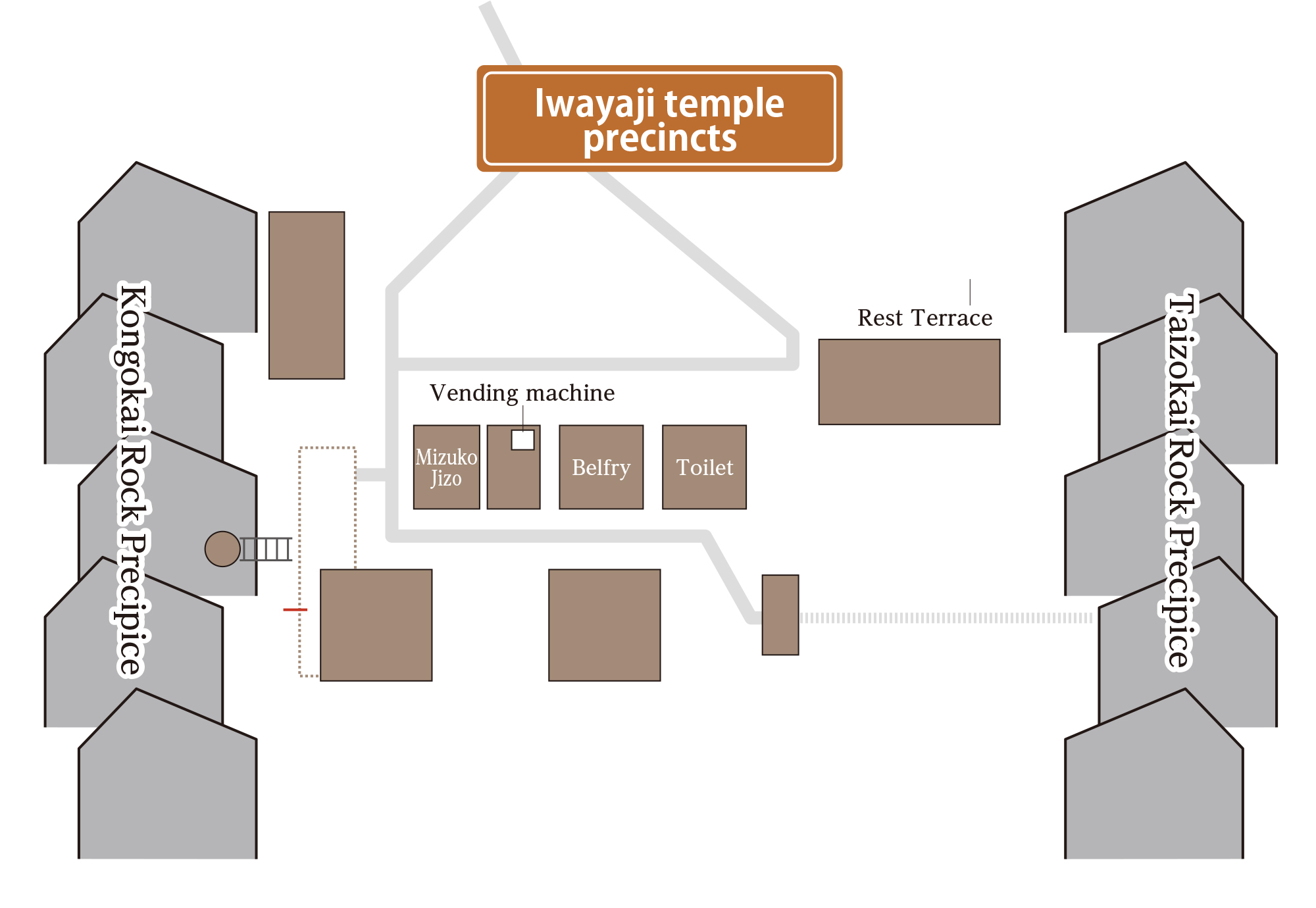Exploring Iwayaji Temple vol.2
Going along the approach
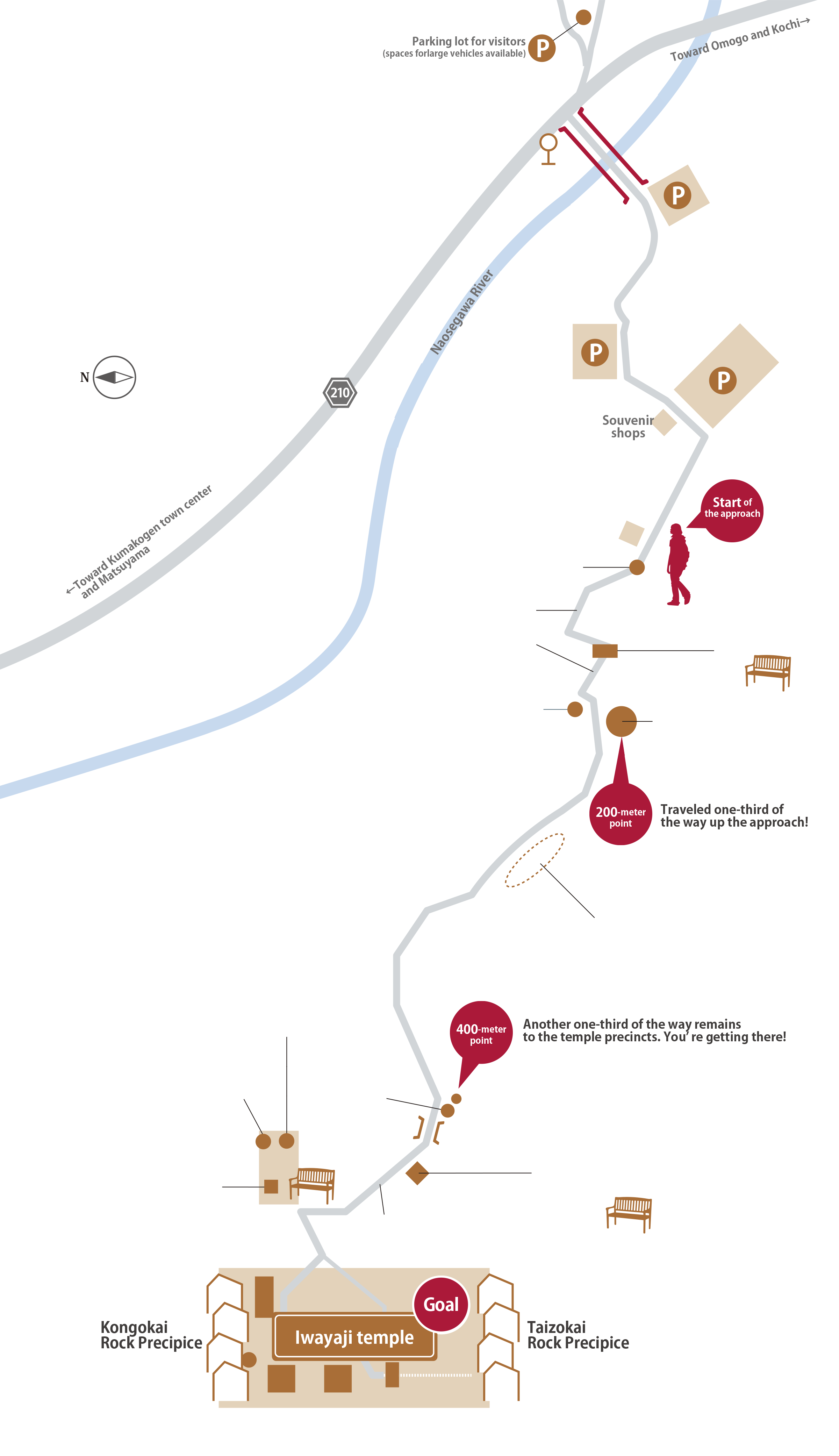
Approach Map
Iwayaji temple is sandwiched between two large rocky precipices.
The approach to the temple precincts is considered one of the most difficult along the pilgrimage route because of its steep slopes and stone steps that stretch for about 600 meters.
Meanwhile, there are a number of attractions dotted along this approach.
Why don’t you take a leisurely walk and savor each of these attractions?
(*Click the points on the map!)
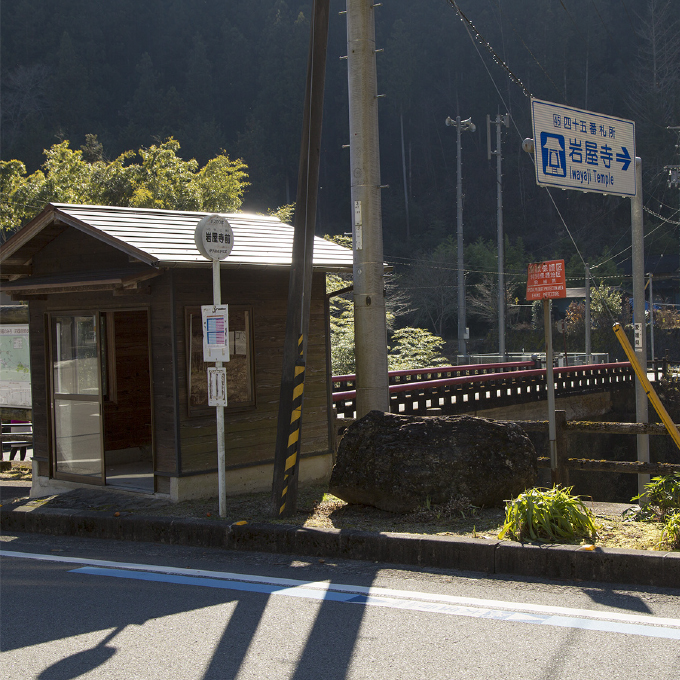
Start at Iwayaji-mae bus stop
If you are coming by public transportation,
get off here.
This is where we start our visit to the temple.
Cross the red-handrail bridge and continue on to the approach.
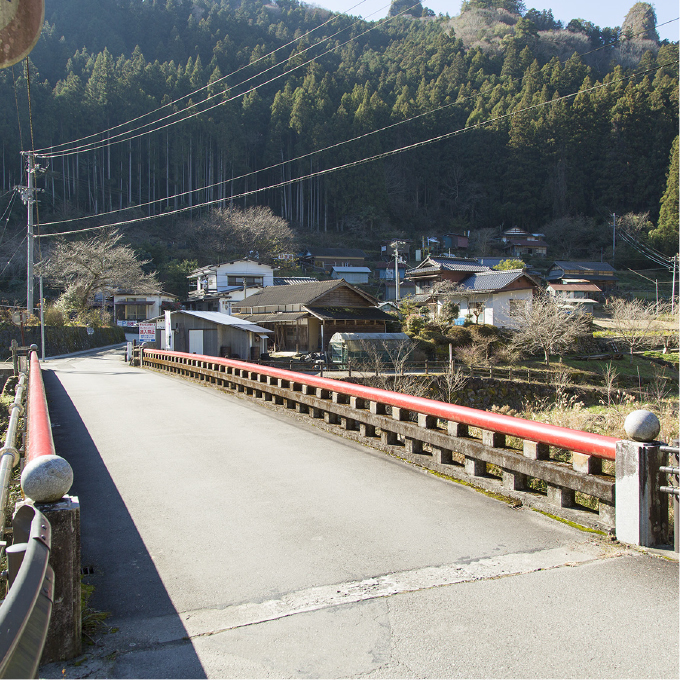
Bridge
The Naosegawa River flows along Prefectural Road 210.
If you cross the red-handrail bridge, you will find the approach to Iwayaji temple.
The road is extremely narrow and lined with houses, so please be careful when passing through.
*Campers and larger-sized vehicles than microbuses are not allowed to enter.
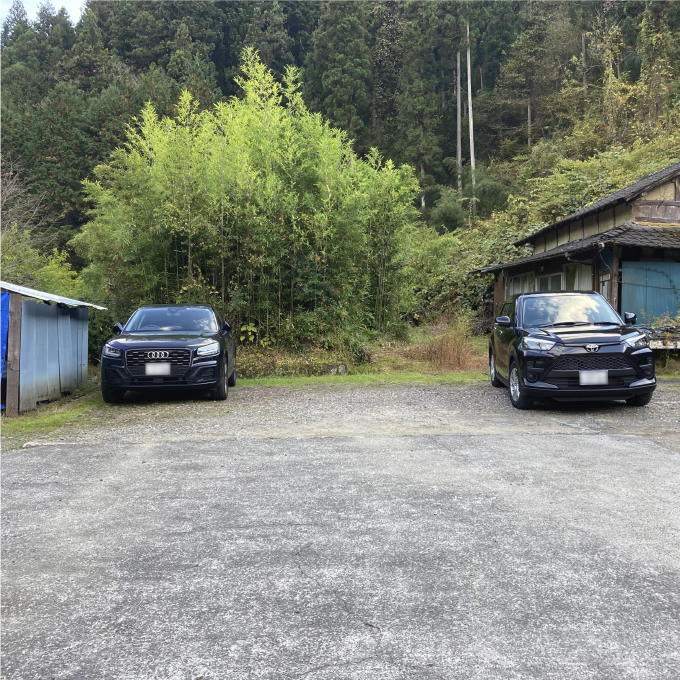
Parking lot for visitors (1)
This is a privately-run parking lot just across the bridge.
P
About 10 parking spaces are available.
300 yen/car
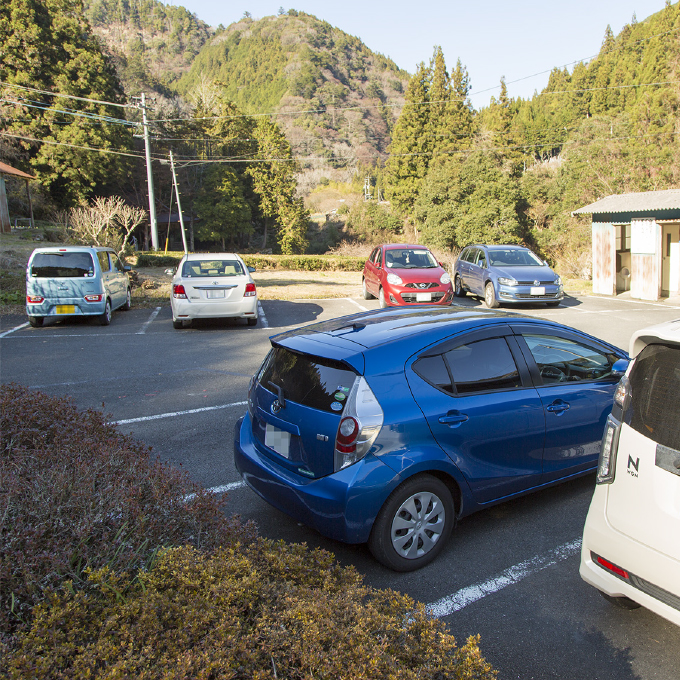
Parking lot for visitors (2)
This is a privately-run parking lot located below the approach to the temple.
It is in a location that provides relatively easy parking.
From here, the path continues uphill toward the approach.
P
Thirteen parking spaces are available.
300 yen/car
(Toilet facilities are available at the site.)
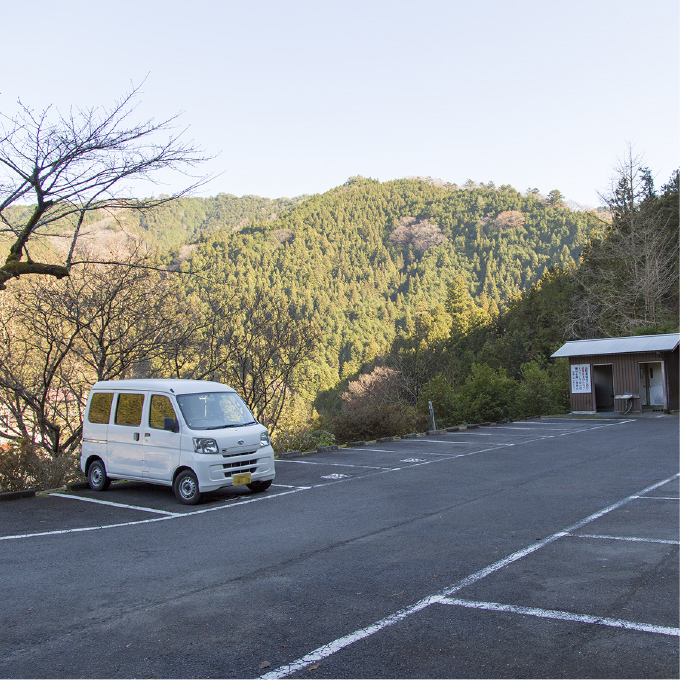
Parking lot for visitors (3)
This is a privately-run parking lot closest to the approach.
If you want to take the shortest way possible,
it is convenient to park here.
P
Twenty-one parking spaces are available.
300 yen/car
(Toilet facilities are available at the site.)
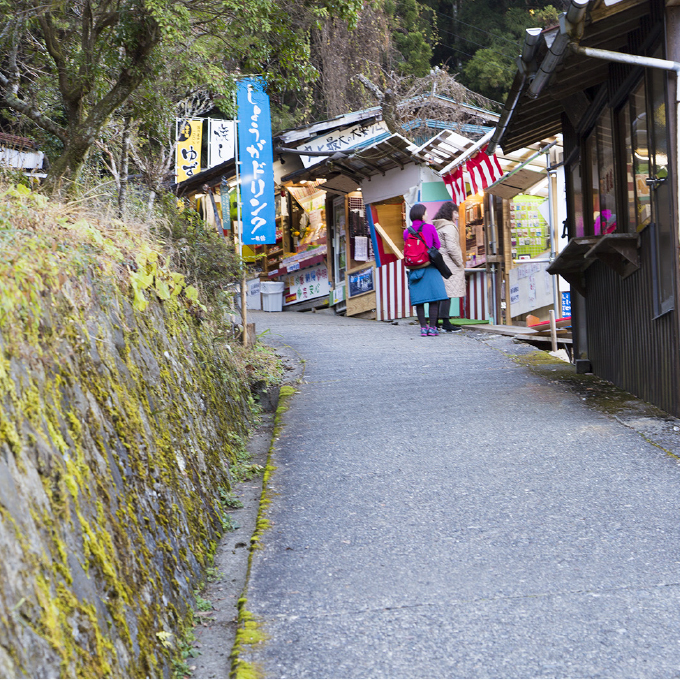
Souvenir shops
There are two souvenir shops along the slope leading to the approach.
They sell a wide variety of souvenirs such as wooden walking staffs (Kongo-zue), white robes, notebooks for vermillion seals (goshuin-cho), hand towels, and key chains.
It’s fun to take a peek, and if the timing is right, you may even be treated to a nice ginger tea.
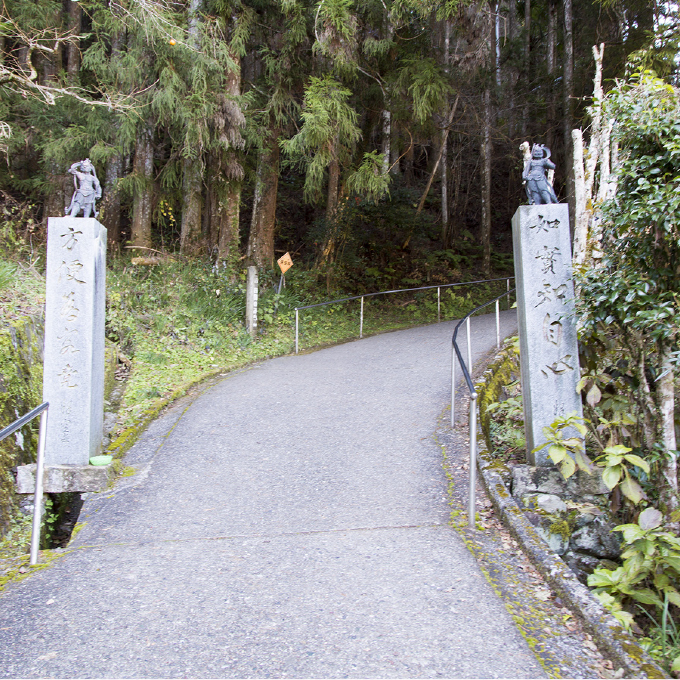
Entrance to the approach
After the stone stele, there are steep ascents and steps that continue for about 700 meters.
Around the approach, cedar, cypress, and horse-chestnut trees soar high into the sky, making it a great place for forest bathing.
There are a few benches placed along the approach, so take a break and enjoy the scenery while walking slowly.
*We recommend that you wear shoes that are comfortable to walk in, such as sneakers with high cushioning.
*After the souvenir shops, there are no vending machines along the approach until you reach the temple precincts.
It would be a good idea to bring your own drinks, especially in the summer when you perspire a great deal.
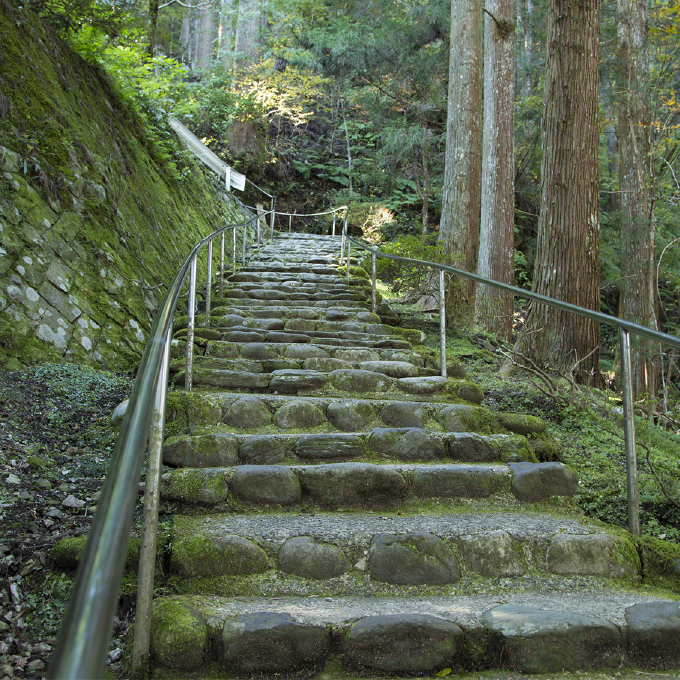
Approach
Stone steps from the entrance to the Temple Gate
A short walk up the hill from the entrance to the approach is a dizzyingly steep slope.
If you are not confident in your physique, you will inevitably get out of breath at this section.
Hold onto the handrails tightly and go up slowly, slowly.
After climbing up the hairpin curved slopes, you will arrive at the Temple Gate.
There are benches placed at the gate, so hang in there for now!
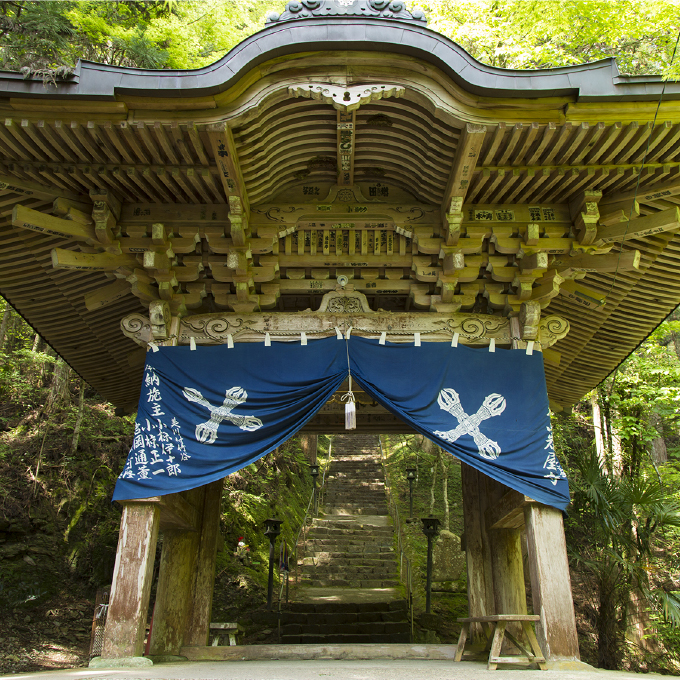
Temple Gate
As you climb the steep stone steps, you will be greeted by a stately gate.
It is said that the gate was completed in 1934 in just three months to coincide with a change of the chief priests.
It is an imposing gate that exhibits the high level of skill of the craftsmen of the time.
Inside the gate, there are benches placed.
Take a moment to catch your breath here before going on further.
→Click here for details.
![]()
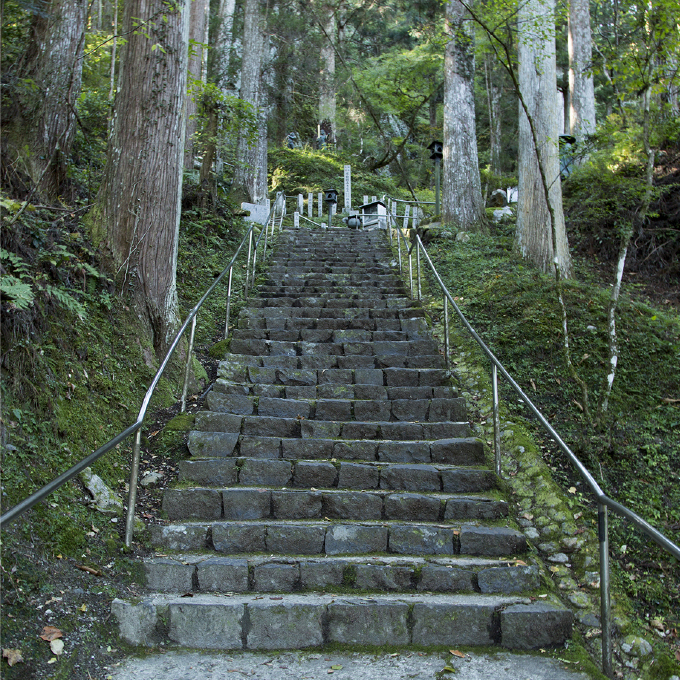
Approach〜山門からの石段〜
山門の向こうにもさらに石段が…。
まだまだ、道のりは序盤です。
ここもゆっくり上っていきましょう。
上りきったら、お不動さまとお大師さんの像が出迎えてくれますよ。
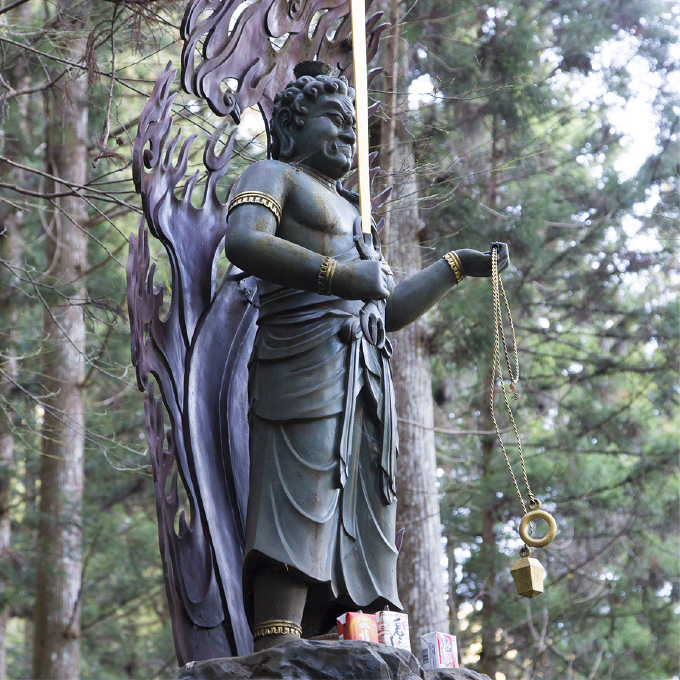
Statue of Fudo Myo-o(Acala Vidyaraja)
The main deity of Kaiganzan Iwayaji temple is Fudo Myo-o.
It is said that the statue of Fudo Myo-o is a manifestation of Dainichi Nyorai (Mahavairocana), who appeared in a different form to protect the people around him.
A small corridor encircles the statue of Fudo Myo-o, and you can carry out a hundred times worship.
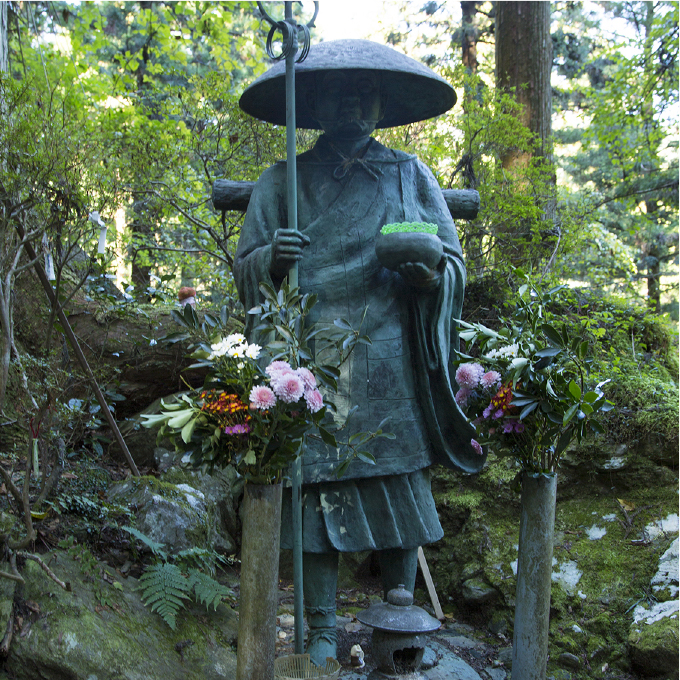
Statue of Kukai in asceticism
It was Kobo-Daishi, Kukai, who opened the pilgrimage route of 88 temples in Shikoku.
It is said that the temple was named Kaiganzan Iwayaji after Kobo-Daishi visited the area and composed a tanka depicting the topography of the mountain, from which the pseudonym of the mountain (Kaiganzan, which literally means “the seaside mountain”) is most likely derived:
Morning mists look like the ocean surface in this deep mountain valley,
and a breeze through the pine trees resembles the ocean wave.
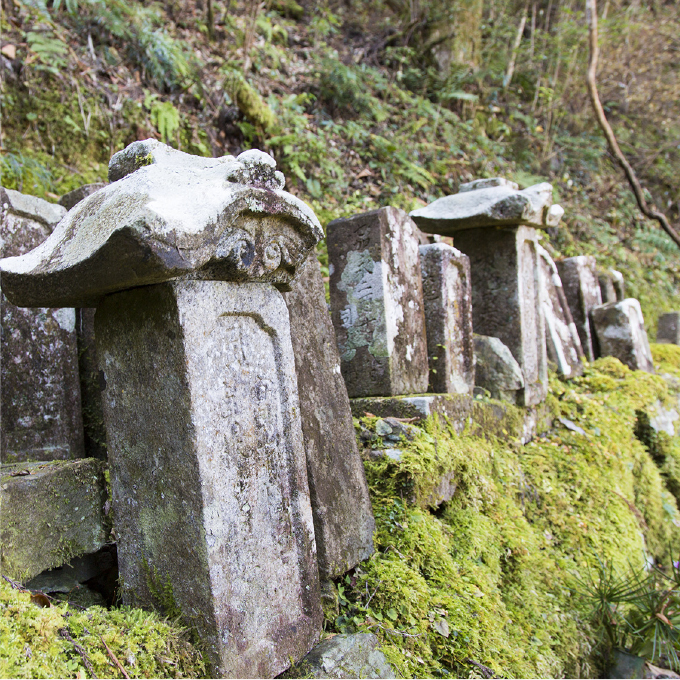
Pilgrims’ graves From hundreds of years ago to the modern era, small grave markers have quietly lined the approach to mourn those who have fallen or died on the pilgrimage, watching over the people who walk along the approach.
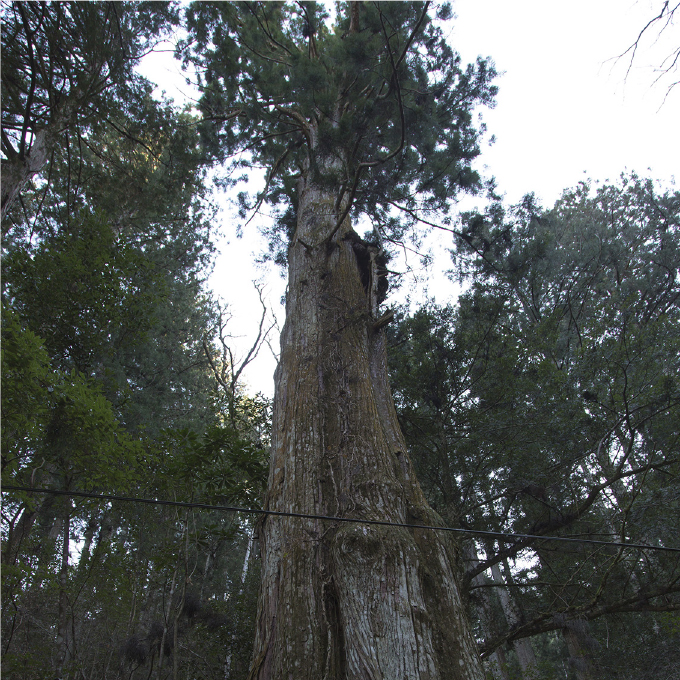
杉の大木
極楽橋の側に、岩屋寺の山内一大きな杉の大木がそびえています。
ぜひ見上げてみてください。
その幹の太さ、天を突くような高さで、悠久の時間を感じさせてくれることでしょう。
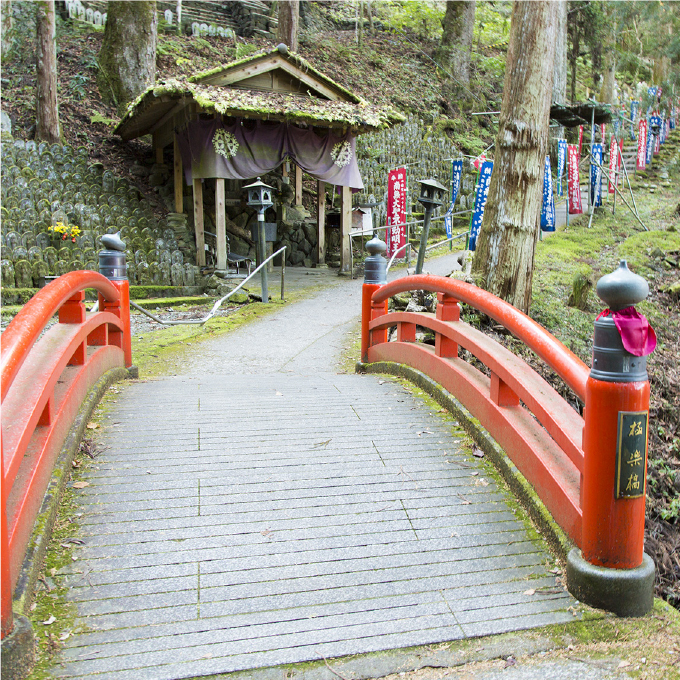
Gokuraku-hashi Bridge(“bridge to the paradise”)
Kobo-Daishi and the Jizo statues near the Gokuraku-hashi Bridge (“bridge to the paradise”).
Hidden at the foot of the bridge is Varuna.
It seems to be so old that its figure is no longer easily recognizable.
Use the long- handled ladle placed on top of the shrine to pour water that has sprung up inside.
![]()
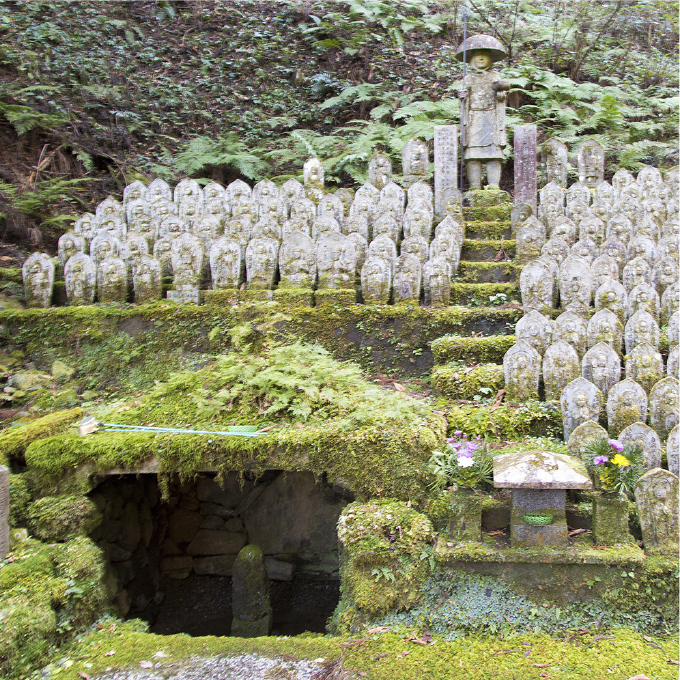
Varuna
Kobo-Daishi and the Jizo statues near the Gokuraku-hashi Bridge (“bridge to the paradise”). Hidden at the foot of the bridge is Varuna.
It seems to be so old that its
figure is no longer easily
recognizable. Use the
long-handled ladle placed on
top of the shrine to pour
water that has sprung up
inside.
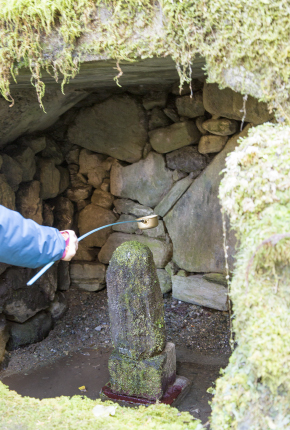
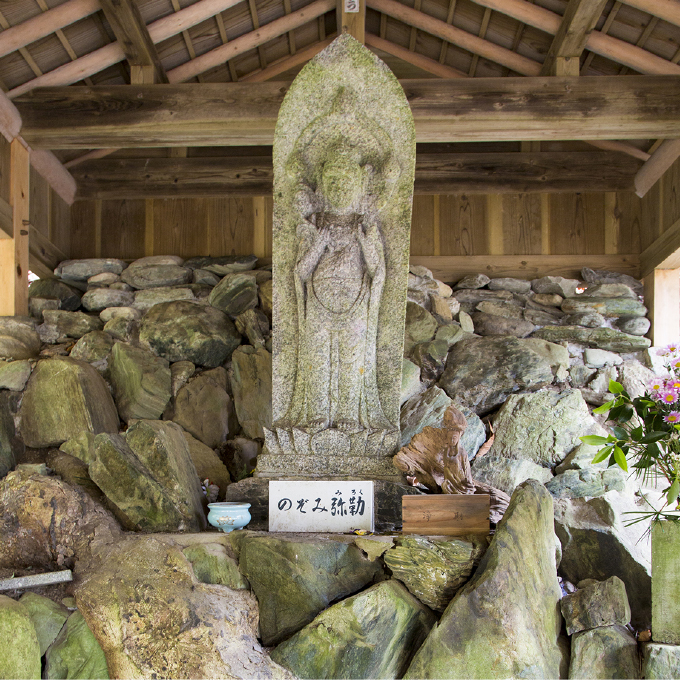
Shrine for Maitreya(Maitreya for prayer) Enshrined in the Shrine for Maitreya is Maitreya Bodhisattva, who will come to this world as a Buddha and save people in the future, 5.67 billion years after Buddha’s demise.
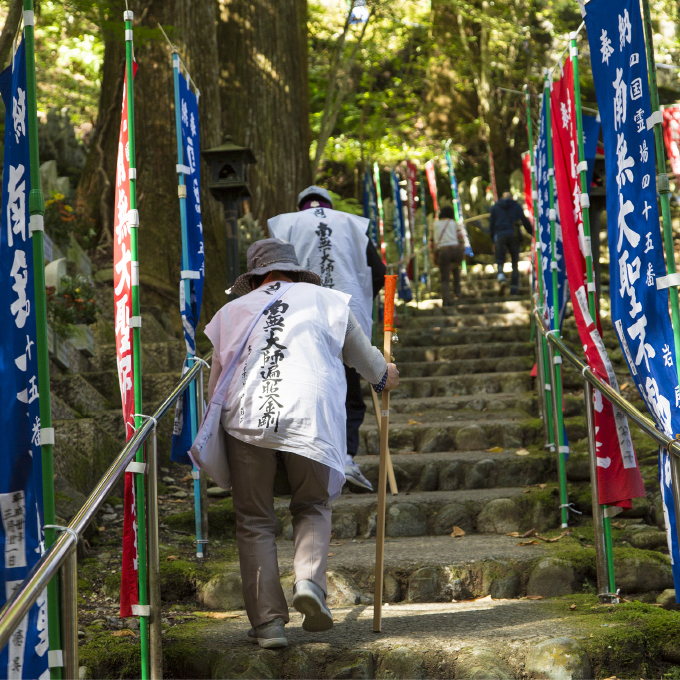
Approach From the Shrine for Maitreya to the Shrine for Kokuzo Bosatsu (Akasagarbha Bodhisattva)
Along the approach to the temple, which is lined with a series of stone steps, there is a line of Jizo statues for eternal memorial services.
Their gentle faces seem to be encouraging us, saying, “You’re almost there.”
If you look up, you can see the buildings of Henjo-kaku and Nokyosho beyond the trees.
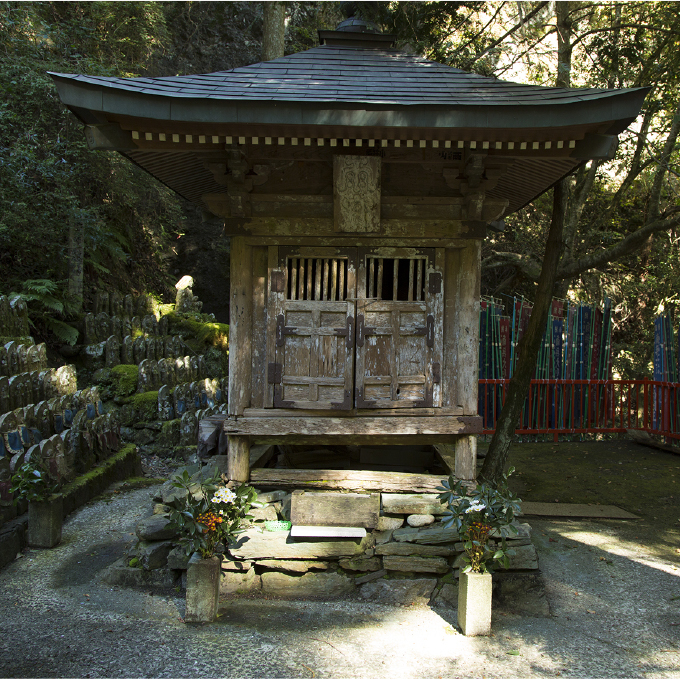
Shrine for Kokuzo Bosatsu(Akasagarbha Bodhisattva)
Built in 1747, the hall is said to be the oldest building in the temple precincts.
The phrase “showering heaps of treasures” carved on a wooden tablet under the eaves symbolizes the benefits of worshipping Kokuzo Bosatsu, which brings infinite treasures of wisdom and fortune.
Benches are placed beside the shrine. Take a moment to catch your breath here before heading to the Main Temple Hall.
→Click here for details.
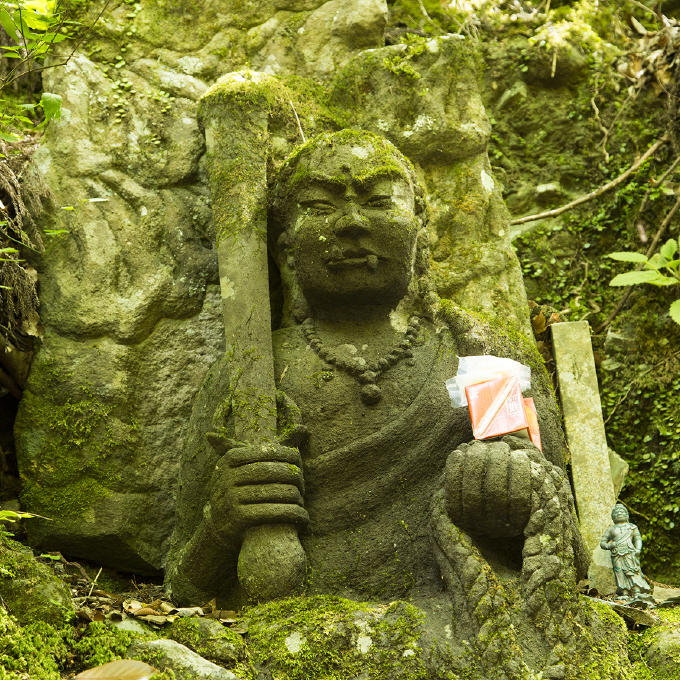
Enlightening Fudoson
A moss-covered stone statue of Fudo Myo-o is looking down at us on the rock wall behind the shrine for Kokuzo Bosatsu.
It is said that many people visit this place to pray when they start something new or when they are stuck in a difficult situation, as it will help them find their way.
Don’t forget to visit this place when you come to Iwayaji temple.
→Click here for details.
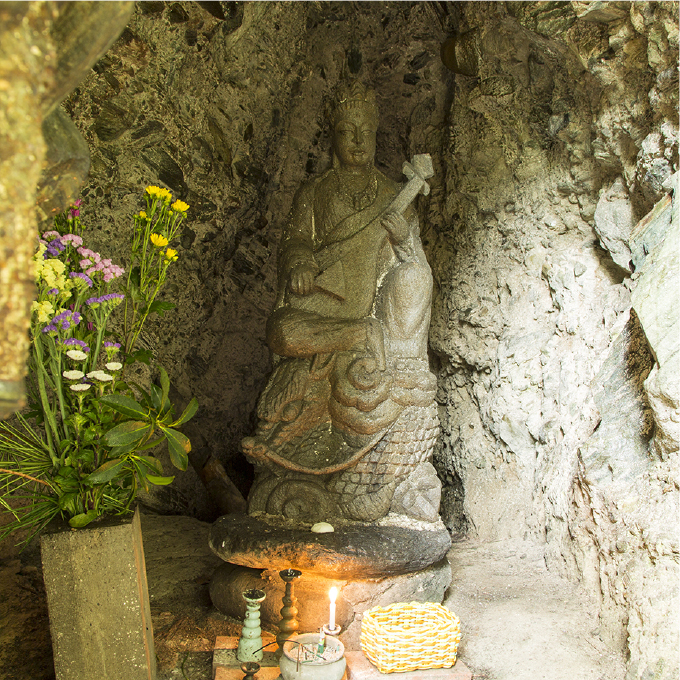
Benzaiten(Sarasvati)
In the cave behind the shrine for Kokuzo Bosatsu, there is a statue of Benzaiten with a graceful expression.
It is said to be beneficial for improving one’s economic fortune.
The Hindu-derived goddess is also worshipped by people involved in artistic pursuits.
→Click here for details.
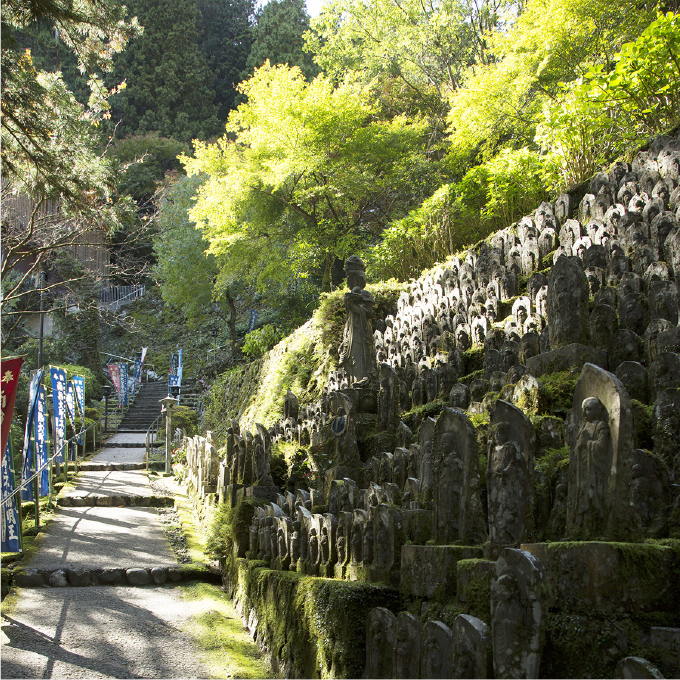
Approach虚空蔵堂から境内へ
虚空蔵堂から見えるなだらかな石段。突き当たりを右手に折れ、最後の急階段を上りきると、ついに境内に到着です。おつかれさまでした!
境内には、本堂、大師堂だけでなく、人々の信仰を集めてきた、さまざまな行場も点在しています。
お時間のある方は、ぜひぜひ体験してみてくださいね。
*詳細はこちらから
→境内の見所・参拝スポット
→仏教体験
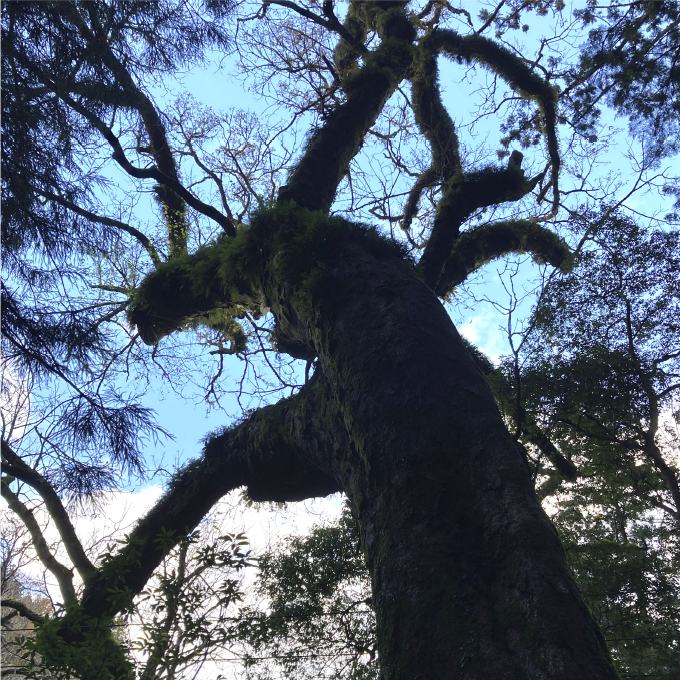
Primeval forest of Japanese horse-chestnut trees
The approach to Iwayaji temple and the area around the temple precincts are covered with a primeval forest of Japanese horse-chestnut trees.
Some of the trees are more than several hundred years old.
When you find a large tree, stop for a moment and look up.
You will surely envisage the history of the mountain in the thickness of the trunk, the lush foliage of the branches, and the treetops.
The area around Iwayaji temple has been designated as a national scenic beauty and a prefectural natural park.


